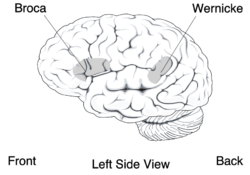Wernicke's Area
| Wernicke's area | |
|---|---|

Approximate location of Wernicke's area highlighted in grey
|
|
| Identifiers | |
| NeuroNames | ancil-252 |
| NeuroLex ID | Wernicke's area |
| Dorlands /Elsevier |
a_59/12151778 |
| FMA | 242178 |
|
Anatomical terms of neuroanatomy
[]
|
|
Wernicke's area (/ˈvɛərnᵻkə/ or /ˈvɛərnᵻki/; German: [ˈvɛʁnɪkə]), also called Wernicke's speech area, is one of the two parts of the cerebral cortex linked, since the late nineteenth century, to speech (the other is Broca's area). It is involved in the comprehension or understanding of written and spoken language (in contrast to Broca's area that is involved in the production of language). It is traditionally thought to be in Brodmann area 22, which is located in the posterior section of the superior temporal gyrus (STG) in the dominant cerebral hemisphere (which is the left hemisphere in about 95% of right handed individuals and 60% of left handed individuals). Damage caused to Wernicke's area results in receptive, fluent aphasia. This means that the person with aphasia will be able to fluently connect words, but the phrases will lack meaning. This is unlike non-fluent aphasia, in which the person will use meaningful words, but in a non-fluent, telegraphic manner.
Wernicke's area is classically located in the posterior section of the superior temporal gyrus (STG) in the (most commonly) left cerebral hemisphere. This area encircles the auditory cortex on the lateral sulcus (the part of the brain where the temporal lobe and parietal lobe meet). This area is neuroanatomically described as the posterior part of Brodmann area 22.
...
Wikipedia
